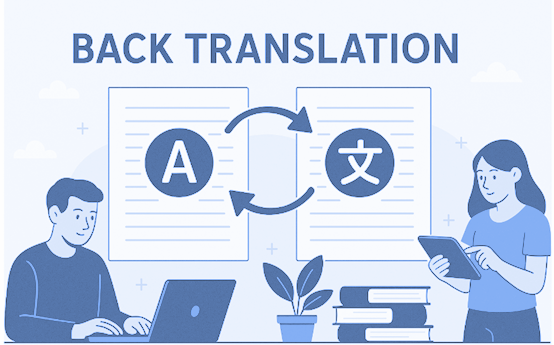أهمية الترجمة العكسية في التواصل متعدد اللغات
أهمية الترجمة العكسية في التواصل متعدد اللغات
لنصل إلى صلب الموضوع، في سوق اليوم العالمي، قد يُكلفك أي خطأ في الترجمة خسارة عملائك، أو مصداقيتك، أو ما هو أسوأ. الأمر ليس مُحرجًا فحسب، بل تتنافس المنظمات الحكومية والشركات والمنظمات غير الربحية على نطاق عالمي هذه الأيام. وماذا عن الترجمات "الجيدة بما يكفي"؟ إنها غير كافية. ستُصاب بالفشل إذا لم تتناسب رسالتك مع السياق أو الثقافة.
يمكن أن تُساعدك الترجمة العكسية في ذلك. اعتبرها أمانك. أرسل محتوى ترجمتك إلى مترجم آخر، والذي بدوره يُعيده إلى اللغة المصدر. يمكنك حينها التأكد من وصول المعنى الحقيقي. أنت في مأمن إن كان قد وصل بالفعل. وإلا، فستكتشف هذه الأخطاء قبل أن تُصبح مشكلةً للآخرين.
ستشرح هذه المقالة ماهية الترجمة العكسية ، وكيف تستخدمها الشركات، ولماذا تُعد فكرة ممتازة، وكيف تُناسب سير عمل الترجمة الفعّال. بصراحة، إنها اختبار سلامة لا ينبغي لأي شركة تُقدّر سمعتها إهماله.
فهم الترجمة العكسية
أصبحت الترجمة العكسية أكثر فائدة. يمكن للمؤسسات تحسين فهمها لجودة ودقة ترجماتها من خلال إعادة المحتوى إلى لغته الأصلية. سنتناول التفاصيل، بما في ذلك الفوائد والحقائق، وكيف تُدمج الشركات الرائدة هذه الخطوة في سير عمل الترجمة لديها.

ما هي الترجمة العكسية؟
يمكن تعريف الترجمة العكسية أيضًا بأنها عملية إعادة ترجمة النصوص التي كانت تُترجم إلى لغة أو لغات أخرى إلى لغة المصدر الأصلية. عادةً ما تُجرى هذه العملية للتحقق من دقة الترجمة الأولى؛ أي كطريقة للتحقق من دقتها مرة أخرى. إليك مثال: إذا ترجمت ملفًا من الإنجليزية إلى الفرنسية وأردت التحقق من تطابقه مع النص الإنجليزي، فستطلب من مترجم آخر إعادة ترجمة النص الفرنسي إلى الإنجليزية.
التطور والسياق التاريخي
تعود فكرة الترجمة العكسية إلى بدايات الدبلوماسية الدولية وترجمة النصوص الدينية. ومن الأمثلة المبكرة على ذلك الكتاب المقدس، حيث جرت جولات عديدة من الترجمة والترجمة العكسية للحفاظ على اتساق المعنى اللاهوتي.
انتشرت الترجمة العكسية بشكل كبير في الأوساط الأكاديمية والسريرية مع بدء انكماش العالم في القرن العشرين - بفضل العولمة. فجأةً، أصبح الجميع يتبادلون الاستبيانات والاختبارات النفسية حول العالم، ولا أحد يرغب في أن يتحول سؤال "الشعور بالحزن" إلى "الشعور بالحزن الحقيقي" في الخارج. لذا، بدأ الباحثون في الترجمة العكسية للتأكد من أن المعنى لم يضيع تمامًا في الترجمة. بصراحة، الأمر أشبه بلعبة هاتف دولية، ولكن بمخاطر أعلى بكثير.
اليوم، تطورت الترجمة العكسية بفضل التكنولوجيا. تستخدم أدوات الذكاء الاصطناعي مثل ConveyThis الترجمة الآلية وفحوصات الجودة للمساعدة في التحقق من محتوى المواقع الإلكترونية والتطبيقات والمستندات بسرعة وموثوقية.
طريقة الترجمة العكسية
الترجمة العكسية ليست مجرد مصطلحات أكاديمية، بل هي ركيزة أساسية في عالم الأعمال للحفاظ على الدقة اللغوية. إليكم كيف تسير هذه العملية فعليًا في عالم الشركات.
1. الترجمة الأولية
يُعهد المحتوى الأصلي أولاً إلى مترجم محترف، يتمتع بخبرة حقيقية في هذا المجال، على عكس أدوات الآلات الآلية. يترجم المترجم المحتوى إلى اللغة (اللغات) التي يطلبها العميل. من المهم أن تكون الترجمة دقيقة، فأي خطأ مهما كان بسيطًا قد يُغير المعنى المقصود. لذلك، لا نقبل أي اختصار، فكل تفصيل مهم لضمان دقة الترجمة ونتائج تلبي توقعات العميل.
2. الترجمة الخلفية
يتدخل مترجم آخر، شخص لم يطلع على النص الأصلي. ما هي مهمته؟ إعادة المستند المترجم إلى لغته الأصلية. بدون أي تلميحات أو اختصارات. إذا بدت النسخة المترجمة عكسية بعض الشيء أو غير متسقة، فهذه علامة تحذير. عندها، عليك تحديد المشاكل، وتحديث الترجمة، والتأكد من أن اتصالاتك التجارية مضمونة قبل نشرها.
3. التدقيق اللغوي
بعد تجهيز الترجمة والترجمة العكسية ، تُرسل إلى مُراجع لغوي. يتولى هذا الشخص مسؤولية مقارنة كلٍّ من الوثيقة الأصلية والترجمة العكسية جنبًا إلى جنب للتحقق من الأخطاء النحوية والتفاصيل الناقصة وأي تناقضات. إذا اكتشف المُراجع أي خطأ، يُسجله ويُعاد للمراجعة.
4. المراجعات النهائية قبل الموافقة
هذه هي المرحلة النهائية، وتستغرق وقتًا طويلًا نظرًا لتعدد جولات المراجعة والتدقيق. وهي بالغة الأهمية، إذ لا مفر منها لتقديم نتيجة دقيقة ومطابقة للمعايير، تُطابق تمامًا توقعات العميل. تصبح الترجمة جاهزة للاستخدام بعد موافقة جميع الأطراف المعنية على النسخة النهائية.
لماذا هي مهمة؟ - إليك فوائد الترجمة العكسية
يتطلب التحقق من دقة المواد المترجمة إعادة الترجمة. فهي تحدد الأخطاء أو السهو أو سوء الفهم الثقافي المحتمل الذي قد يكون حدث أثناء عملية الترجمة الأولية.
تحسين دقة الترجمة
الترجمة في القطاعات شديدة التنظيم، مثل الطب والتمويل، تتطلب الامتثال للقانون واللغة. يتطلب إنشاء المستندات، خاصةً عند التعامل مع معلومات سرية مثل بيانات المرضى أو التجارب السريرية، الامتثال للقوانين واللوائح المحلية. وكثيرًا ما يُطلب في هذه الحالات الترجمة العكسية ، أي عكس المستند إلى لغته الأصلية لضمان دقته.
تلبية معايير الامتثال
سواءً تعلق الأمر بالحصول على موافقة لتجربة دوائية أو بنشر السجلات المالية عالميًا، يجب أن تستوفي الوثائق في القطاعات الخاضعة للرقابة المعايير القانونية الصارمة. أحيانًا، تحتاج الهيئات التنظيمية إلى الترجمة العكسية لضمان عدم إغفال أي شيء أو تقديمه بشكل غير صحيح خلال عملية الترجمة. توفر هذه التقنية درجةً مهمةً من التحقق عندما يكون الوضوح والامتثال في قمة الأولويات.
تطوير المصداقية بين الجماهير في جميع أنحاء العالم
الثقة أساس خطة تواصل عالمية ناجحة. لا تقتصر الترجمة على نقل المعلومات في قطاعات شديدة الرقابة مثل المالية والصيدلة، بل تشمل أيضًا الامتثال. عند تجميع المستندات، ثمة ضرورة ملحة للامتثال للأنظمة والقوانين المحلية، لا سيما عند التعامل مع معلومات حساسة مثل سجلات المرضى أو التجارب السريرية. أما الترجمة العكسية ، حيث يُعاد ترجمة المستند إلى لغته الأصلية للتحقق من دقته، فهي ليست مستحبة فحسب، بل إلزامية في كثير من الحالات.
التحديات والقيود
على الرغم من فائدتها في التحقق من دقة المواد المترجمة، إلا أن الترجمة العكسية لها عدة عيوب وقيود. من أهمها:
- قد تستغرق العملية وقتًا طويلًا وتكون مكلفة. عادةً ما تكون الترجمة التكرارية عملية طويلة تتطلب موارد كثيرة. فريق من المحترفين يتكون من مترجمين ومدققين لغويين يخضعون لمستويات مراجعة مختلفة. كل هذا قد يبدأ بالتراكم، خاصةً في المشاريع الأكثر تعقيدًا أو الأكبر حجمًا.
- مشاكل في الترجمة الحرفية. تُركّز الترجمة العكسية على الدقة الحرفية، مما يُؤدي إلى اختفاء العديد من الفروق الثقافية والتعبيرات الاصطلاحية والعناصر الأسلوبية من اللغة المصدر. غالبًا ما تتدهور جودة الترجمة الأصلية ومحتواها أثناء الترجمة العكسية.
- احتمالية وجود نتائج إيجابية خاطئة. حتى التغييرات الطفيفة في الصياغة التي لا تُحدث تأثيرًا نهائيًا، يُمكن أحيانًا اكتشافها وتصحيحها، مما يُؤدي إلى تصحيح أخطاء غير ضرورية. يُؤدي سوء تفسير اختيارات الكلمات الشخصية إلى مواقف مُربكة، حيث تُؤدي الاختلافات إلى تعديلات غير مقصودة، مما يُؤدي إلى ضياع الوقت والقيمة.
استراتيجيات التخفيف
ولمعالجة هذه المشاكل:
- انتبه إلى العد الدلالي ، بدلاً من الربط بين الكلمات
- توظيف مترجمين خلفيين ذوي كفاءة ، والذين هم متخصصون في هذا المجال.
- قم بتحديد فئات تقييم محددة لفصل الاختلافات النقدية عن الاختلافات الأسلوبية.
- استخدم برامج إدارة المشاريع لتحسين الاتصالات والإصدارات.
طرق تحقيق ترجمة ناجحة للظهر
لتحقيق نجاح عمليات الترجمة العكسية، لا بد من الاهتمام بعمليات كل مرحلة بالتفصيل. تتطلب كل مرحلة خطة واضحة، تتضمن اختيار المترجمين الأمثل وتنفيذ كل عملية تواصل.
اختيار المترجمين المهرة
اختر خبراء يتمتعون بمهارات ثنائية اللغة وفهم ثقافي مشترك. يتطلب السيناريو الأمثل أن يكون المترجمون متحدثين أصليين للغة الهدف للترجمة الأولية، ومتحدثين أصليين للغة المصدر للترجمة العكسية . تكتسب الخبرة في مجال التخصص أهمية بالغة في المجالات التقنية والتخصصية.
وضع إرشادات واضحة
ابدأ الإجراء من خلال تحديد توقعات واضحة فيما يتعلق بما يلي:
- استخدام المصطلحات
- الاختلافات المقبولة
- الفروق الثقافية
- التنسيق والبنية
إن وجود إرشادات واضحة يقلل من سوء الفهم المحتمل مع الحفاظ على التوحيد في النصوص المترجمة.
استخدام التكنولوجيا والأدوات
تعمل أدوات مثل أنظمة إدارة الترجمة والقواميس وأدوات الترجمة بمساعدة الحاسوب على تبسيط عملية الترجمة العكسية من خلال:
- تعزيز الاتساق
- مراقبة التغييرات
- تنظيم سير العمل
- تقديم التحكم في الإصدار
إن الوصول إلى الأدوات المناسبة يضمن اتخاذ قرارات عمل أكثر ذكاءً، وليس فقط تحسين الترجمة. إن تقليل الأخطاء والقضاء على أوجه القصور يوفر موارد قيّمة.
خدمات الترجمة الخلفية
عند الحاجة إلى خدمة ترجمة في مؤسستك، قد تكون الترجمة العكسية خدمةً مهمةً للاستفادة منها. يوفر العديد من مقدمي خدمات الترجمة خدمات الترجمة العكسية للتحقق من المعنى، والأهمية الثقافية، وملاءمة السياق، مع التحقق من الأخطاء في الترجمات.
ما هو المطلوب من الشركة للحصول على خدمات الترجمة العكسية؟
- المحترفون المؤهلون : إن العمل مع مترجمين مؤهلين يتمتعون بكفاءة ممتازة في كل من اللغتين المصدر والهدف أمر حيوي للغاية لضمان الترجمات الصحيحة.
- المترجمون الخلفيون : هم الأشخاص الذين لم يطلعوا على المستند المصدر للمساعدة في القضاء على أي تحيز محتمل في عملية الترجمة.
- عملية مراقبة الجودة: بدون هذا النظام، لن يكون من الممكن اكتشاف الأخطاء فيما يتعلق بالوثيقة المترجمة مرة أخرى والنص الأصلي.
- التواصل الواضح: يُساعد التفاعل الفعال على الفهم. في هذه الحالة، من الضروري أن يكون هناك تواصل بين العميل والمترجم فيما يتعلق بهدف الترجمة واحتياجات الترجمة العكسية .
أمثلة واقعية على الترجمة العكسية
دعونا نلقي نظرة على بعض الأمثلة لتحليل المفهوم والمنهجية وراء الترجمة العكسية :
-
يمر الوقت بسرعة عندما تستمتع.
مترجم (الإيطالية): Il tempo vola quando ti diverti.
الوقت يمر بسرعة عندما تستمتع.
➜ تحتفظ العبارة بمعناها وصياغتها الأصلية، مما يدل على الترجمة المباشرة ذات التوافق الثقافي. -
الأصل (الإنجليزية): كسر ساق!.
ترجمة (اليابانية):成功を祈るよ.
أتمنى لك النجاح .
➜ صُمِّمت هذه العبارة محليًا للفهم الثقافي. حُفظ معناها، لكن التعبير تغير كليًا. -
لقد كشفت الحقيقة !
مترجم (البرتغالية): Ela revelou o segredo!
كشفت السر !
➜ يُظهر هذا تعبيرًا ترجمته من أجل الوضوح، مع الحفاظ على القصد ولكن تغيير الاستعارة.
دمج الترجمة العكسية في سير عملك
عند تضمين الترجمة العكسية في عمليتك، يمكنك تعزيز دقة ترجماتك وتجانسها. كما يوفر هذا خطوة إضافية للتحقق من الجودة.
متى يتم تنفيذ الترجمة العكسية؟
الترجمة العكسية ليست ضرورية لجميع المشاريع. فكّر في تطبيقها في الحالات التالية:
- تعتبر الدقة ضرورة أساسية في الصناعات مثل:
- قانوني
- طبي
- الوثائق المالية .
- تتطلب مهمة الترجمة إلى العديد من اللغات إخراجًا متسقًا.
- إن وجود الحساسيات الثقافية واللغوية يطرح تحديات معقدة.
- يتطلب التعاون مع الهيئات التنظيمية والمراجعين تعاونك.
تبسيط عملية الترجمة العكسية
لدمج الترجمة العكسية بكفاءة:
- تجنب التسرع في اللحظات الأخيرة: تأكد من عدم تأجيل الترجمة إلى اللحظة الأخيرة، لأن ذلك سيؤدي إلى تأخيرات مستقبلية.
- حافظ على وضوح مستنداتك: قم بمركزية جميع الإصدارات والتحديثات والتعليقات بحيث تكون المستندات متسقة وسهلة الوصول إليها.
- استخدم التكنولوجيا : استخدم أدوات تقنية مثل ConveyThis . فهي تُساعد في إدارة سير العمل، وتتبُّع التغييرات، والحفاظ على اتساق المصطلحات. لا داعي للعناء اليدوي.
- تعزيز تنسيق الفريق : يجب على جميع المشاركين في العملية، من مترجمين ومراجعين وخبراء متخصصين، الاتفاق على الأهداف، والوضوح بشأن ما يفعلونه وتوقيته، وبالتالي تجنب أي غموض لاحقًا عند عدم توافق التوقعات مُسبقًا. عندما تتوافق توقعات جميع أعضاء الفريق في بداية المشروع، يصبح سير العمل أكثر سلاسة.
كذلك، إذا دعمتَ الترجمة العكسية خلال الجزء الأول من العملية، فإنك تُعزز عملية مراقبة الجودة بشكل كبير. بهذه الطريقة، يمكنك الالتزام بالجدول الزمني والميزانية المتعاقد عليها دون أي مفاجآت أو تكاليف غير متوقعة. كما أن تضمين الترجمة العكسية في بداية العملية سيساعد أيضًا على تعزيز مراقبة الجودة، والالتزام بالعقد، والجدول الزمني المخطط له، مع تجنب أخطاء النطاق أو التكاليف.
الكلمة الختامية
الترجمة العكسية ليست خطوةً غير ضرورية، بل هي ضروريةٌ لتحقيق تواصلٍ دقيقٍ متعدد اللغات . فهي تُساعد على تجنب الأخطاء المُكلفة، وتُحافظ على رضا قسم الامتثال لديك، وتُعزز ثقة العملاء الدوليين . بالطبع، تتطلب هذه الترجمة استثمارًا أكبر في الوقت والموارد، ولكنها ضروريةٌ في القطاعات ذات المخاطر العالية مثل القانون والرعاية الصحية.
عليك أن تعرف متى وكيف تستخدم الترجمة العكسية لتحقيق أقصى استفادة منها. إذا استُخدمت بذكاء، فهي جزء أساسي من أي استراتيجية تواصل عالمية جادة.
منصات مثل ConveyThis تُسهّل العملية برمتها، من الأوراق الطبية إلى الاتفاقيات القانونية وصولاً إلى المواد التسويقية المُحسّنة. تُعدّ الترجمة العكسية طبقةً إضافيةً من شبكة أمان ضمان الجودة لديك. فهي تُساعد في اكتشاف الأخطاء قبل أن تتحوّل إلى مشكلة، وهي خطوةٌ ذكيةٌ دائمًا.
إن فهم الفروق الدقيقة في تطبيق الترجمة العكسية يمكّنك من تحقيق أقصى قدر من الفعالية.
مقالة بقلم كافيتا ر.
الترجمة هي أكثر بكثير من مجرد معرفة اللغات، فهي عملية معقدة.
By following our tips and using ConveyThis , your translated pages will resonate with your audience, feeling native to the target language.
While it demands effort, the result is rewarding. If you’re translating a website, ConveyThis can save you hours with automated machine translation.
جرب ConveyThis مجانًا لمدة 3 أيام!
 لا حاجة لبيانات البطاقة
لا حاجة لبيانات البطاقة



